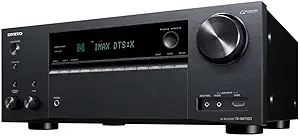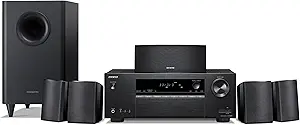Prominent contenders in the audio/video receiver sphere, Onkyo and Sony stand as pillars of innovation, each boasting distinctive merits and functionalities. Onkyo AV receivers carve a niche for themselves with their renowned prowess in delivering pristine sound reproduction, courtesy of their proprietary VLSC (Vector Linear Shaping Circuitry) technology. This cutting-edge feature eradicates pulse noise, preserving the integrity of the original recording. Furthermore, Onkyo receivers excel in accommodating the latest audio formats like Dolby Atmos and DTS:X, ensuring an immersive auditory journey. Nonetheless, some users have voiced concerns regarding reliability issues, particularly relating to HDMI board failures, casting a shadow over their otherwise stellar performance. Conversely, Sony AV receivers shine in their intuitive user interface and seamless compatibility with other Sony products. Powered by Sony's Digital Cinema Auto Calibration (DCAC) technology, these receivers fine-tune sound settings based on your room's acoustics, promising an optimized listening experience. Moreover, Sony receivers embrace the forefront of audio innovation by supporting cutting-edge formats like Dolby Atmos and DTS:X, alongside offering advanced features such as 4K HDR pass-through and eARC support. Despite these commendable attributes, detractors have highlighted Sony receivers' limited customizability and EQ settings compared to rival brands, warranting a closer inspection of user preferences before making a decision.
Product Selection
In the realm of audio equipment, Onkyo AV Receivers and Sony AV Receivers offer a wide range of options, each with its own distinctive features and benefits. Onkyo AV receivers are renowned for their support of high-resolution audio formats like DTS:X and Dolby Atmos, promising an immersive listening experience. Their lineup includes receivers with varying power outputs and features to cater to different user needs, with flagship models like the TX-NR696 boasting features such as THX Certified Select for superior sound quality and Dynamic Audio Amplification for precise control over audio dynamics. On the other hand, Sony AV receivers offer an equally impressive selection, with models designed to support both 8K and 4K resolutions, making them ideal for users seeking high-definition home theater setups. Sony receivers like the STR-DN1080 introduce innovative technologies like Phantom Surround Back, which simulates the effect of physical surround back speakers for a more immersive audio experience. However, compared to Onkyo, Sony receivers may lack certain high-end audio features such as THX certification. Overall, while both brands offer extensive product lines, Sony's emphasis on advanced audio technologies and high-definition resolutions may appeal more to discerning audiophiles.
Availability
In the domain of audio and home entertainment systems, Sony and Onkyo emerge as prominent contenders, each presenting distinct advantages and challenges in terms of accessibility. Sony AV receivers benefit from widespread availability across various global markets, thanks to the brand's pervasive popularity and robust distribution network. Consumers can easily locate and acquire Sony's latest offerings, such as the renowned STR-DH790, revered for its Dolby Atmos and DTS:X support, through major retail chains and online platforms like Amazon. In contrast, although Onkyo AV receivers maintain a presence in diverse markets worldwide, their distribution network falls short of Sony's extensive reach. This discrepancy may present hurdles for customers seeking Onkyo products, particularly the latest models like the TX-NR696, acclaimed for features such as THX Certified Select and Dolby Atmos support. Nonetheless, Onkyo compensates for its physical limitations with a robust online presence, enabling convenient purchases through their official website and other digital retail platforms. Despite the minor constraints in physical availability, Onkyo receivers garner accolades for their exceptional sound quality and advanced functionalities, making them an appealing choice for discerning audio enthusiasts.
Design/Look
Onkyo AV Receivers and Sony AV Receivers lead the market in audio equipment, each distinguished by its unique style and design. Onkyo AV Receivers are admired for their sturdy and robust build, often characterized by a prominent central volume knob, an array of control buttons, and an extensive display interface. The latest models, represented by the Onkyo TX-NR696, showcase a sophisticated black design with brushed metal accents, emitting a modern and refined appeal. However, concerns have been raised regarding the complexity of Onkyo's interface, which may present challenges for users unfamiliar with audio equipment. In contrast, Sony AV Receivers, epitomized by the Sony STR-DN1080, are praised for their minimalist and elegant design philosophy. Featuring a compact and streamlined profile with fewer control buttons and a simplified display, Sony receivers prioritize ease of use. The brand's recent releases feature a sleek black or dark gray finish, seamlessly integrating into any home theater setup. Nevertheless, criticisms have emerged regarding the minimalist approach, as it may result in fewer direct access controls, potentially limiting the preferences of users who prefer more manual control over their audio settings.
Price
When it comes to pricing, both Onkyo and Sony AV receivers offer a range of options to suit various budgetary needs. Onkyo AV receivers, like the TX-NR696, often provide competitive pricing, delivering advanced features such as Dolby Atmos and DTS:X support, seamless 4K HDR pass-through, and integrated streaming services, all within a mid-range price range. Onkyo's reputation for delivering premium sound quality and robust power output at an affordable price makes it a popular choice among budget-conscious audiophiles. In contrast, Sony tends to position its AV receivers, such as the STR-DN1080, at a slightly higher price point. This higher price is justified by Sony's inclusion of proprietary technologies like the Digital Cinema Auto Calibration (DCAC) system for optimized sound reproduction and support for high-resolution audio formats. Sony AV receivers also offer compatibility with the latest audio standards and come with built-in Chromecast and Spotify Connect functionalities. However, compared to competitors in the same price range, Sony may offer fewer HDMI inputs, which could be a limitation for some users. Ultimately, the choice between Onkyo and Sony depends on the specific features and technologies that each user prioritizes.
Quality/Durability
Renowned for their unmatched audio quality and durability, Onkyo AV Receivers set industry standards. Featuring state-of-the-art technologies like Dolby Atmos and DTS:X, they deliver immersive 3D soundscapes, powered by high-current analog amplification for pure, impactful audio output. Onkyo's commitment to craftsmanship is evident in their sturdy build, designed to minimize vibrations, and premium terminals for reliable connections. However, concerns have arisen regarding potential HDMI board failures over time, posing potential repair expenses. In contrast, Sony AV Receivers are lauded for their outstanding sound fidelity and resilience. Equipped with features like 4K HDR pass-through and Dolby Vision compatibility, they enhance both visual and auditory performance. Sony's exclusive Digital Cinema Auto Calibration (DCAC) technology optimizes sound settings automatically for an enhanced audio experience. While Sony receivers are generally robust, criticism has surfaced regarding their complex user interface and occasional navigational difficulties.
Reputation
In the domain of audio equipment, Onkyo and Sony stand as stalwarts, renowned for their AV receivers that embody years of excellence in delivering top-tier products. Onkyo AV receivers are acclaimed for their exceptional sound quality, featuring cutting-edge technologies like Dolby Atmos and DTS:X for unmatched auditory immersion. Additionally, their sophisticated calibration systems, such as AccuEQ Room Calibration, meticulously adjust sound settings to harmonize with the distinct acoustics of any environment. However, concerns have arisen among certain users regarding reliability issues, with some units experiencing failures after a few years of use, posing a notable drawback for Onkyo receivers. Conversely, Sony AV receivers command attention with their remarkable sound reproduction capabilities, bolstered by technologies like Dolby Atmos, DTS:X, and Sony's proprietary sound field modeling technology, which faithfully replicates the ambiance of renowned concert halls and theaters. Sony receivers are also esteemed for their durability and resilience. Nonetheless, criticisms have surfaced regarding Sony's user interface, which some users find less intuitive compared to competitors. In essence, while both brands enjoy esteemed positions in the audio equipment industry, Onkyo is lauded for its sound quality and advanced features, whereas Sony earns recognition for its reliability and longevity.
Warranty
Both Onkyo and Sony AV receivers are esteemed for their top-notch audio equipment, yet disparities exist in their warranty policies, warranting scrutiny from prospective purchasers. Onkyo typically offers a standard two-year warranty, safeguarding against defects in materials and workmanship during regular use. This timeframe is industry-standard, affording users ample opportunity to identify and address any potential concerns. Conversely, Sony AV receivers boast a lengthier three-year warranty, providing an additional year of coverage compared to Onkyo's standard offering. This extended duration may prove pivotal for users seeking added reassurance and safeguarding against unforeseen issues. However, it's crucial to recognize that both warranties exclude damages stemming from misuse, neglect, or unauthorized alterations and repairs. While both Onkyo and Sony deliver competitive warranty terms relative to other brands, Sony's extended warranty period offers a slight edge in terms of consumer protection.
Easy To Use
Sony AV Receivers have earned acclaim for their user-friendly interface and straightforward setup procedures. The latest models, such as the STR-DN1080, feature a guided setup assistant that simplifies the initial configuration process, particularly beneficial for users less tech-savvy. Sony's interface is marked by its clarity and ease of use, featuring well-defined buttons and settings for effortless navigation. The accompanying remote control is thoughtfully crafted, boasting a logical layout that allows for easy adjustment of volume, source selection, and access to additional features. However, concerns have been raised regarding the complexity of the menu system, posing challenges for some users during navigation.
On the other hand, Onkyo AV Receivers, exemplified by the TX-NR696, are celebrated for their user-friendly design. Onkyo's interface prioritizes simplicity and clarity, empowering users to quickly locate and adjust settings as needed. The remote control mirrors this simplicity with its large, clearly labeled buttons. The setup process is similarly straightforward, aided by an on-screen guide. Nonetheless, criticisms have emerged regarding the abundance of buttons on Onkyo's remote control, which may appear overwhelming to some users. Additionally, while the menu system is generally navigable, users may require some time to familiarize themselves fully with its intricacies.
Compared to competitors, both Sony and Onkyo AV Receivers excel in offering user-friendly interfaces and hassle-free setup procedures. However, preferences may differ regarding the specific design of the interface and remote control, highlighting the subjective nature of the user experience.
Conclusion
The audio and visual capabilities of Onkyo and Sony AV receivers impress with cutting-edge technologies and features currently available in the market. Onkyo AV receivers are acclaimed for their support of high-resolution audio, featuring immersive DTS:X and Dolby Atmos technologies that transport users into realistic soundscapes. Additionally, they integrate Chromecast built-in, DTS Play-Fi, and FlareConnect for seamless multi-room audio experiences. However, there have been reports from some users concerning HDMI board issues, potentially impacting the overall performance of the receiver. Conversely, Sony AV receivers deliver high-resolution audio with DTS:X and Dolby Atmos support, alongside boasting exceptional video quality with features such as 4K HDR pass-through and Dolby Vision, ensuring breathtaking visuals. Sony receivers also offer Music Connect for seamless integration with home automation systems. Nevertheless, they often come with a higher price tag compared to Onkyo receivers, and some users find their user interface less intuitive. While both Onkyo and Sony present competitive features and technologies, the decision between the two may ultimately hinge on individual user requirements and budget constraints.



















